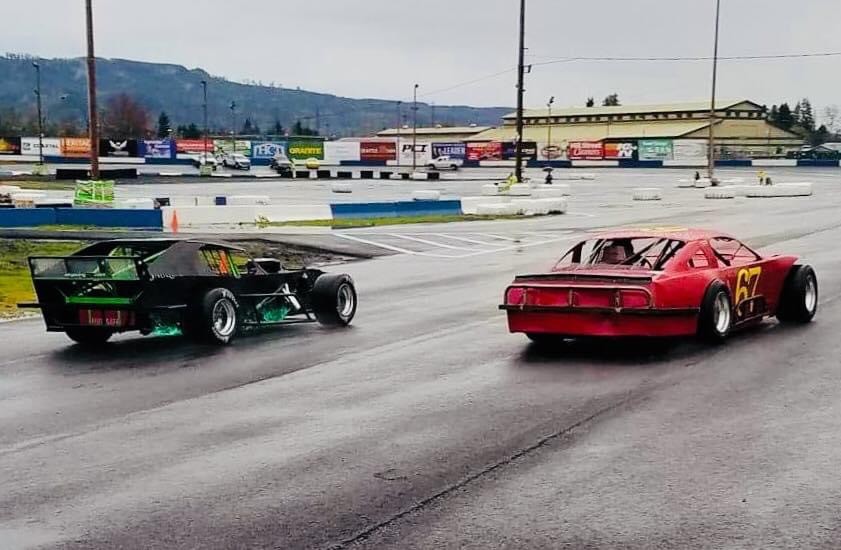From drinking pickle juice as a pre-race day routine to passing drivers in the intersection, Mackenzie Deitz was crowned Evergreen Speedway’s first female Figure 8 champion in the BECU Super Stock Figure 8 Division in September.
Born and raised in Washington and having lived in Monroe for the past five years, Deitz eats, breathes and sleeps racing. From the time she was one week old attending races at Evergreen Speedway, the only NASCAR-sanctioned track in Washington state, she’s followed in the footsteps of her grandfather, Vern Deitz, who won three Figure 8 championships (1982, 1984, 1985) and three Figure 8 Nationals titles (1984, 1990, 1994). Deitz’s crew partner and husband, Jake Repin, is also a two-time Figure 8 champion (2010, 2012). And though Deitz didn’t begin racing competitively until she was 26 years old in 2017, she’s already driven through barriers on the track.
In this interview, Deitz discussed her racing journey, everything from driving go-karts on her grandparent’s track and moving into the Figure 8 class to inspiring the next generation of drivers and leaving critics and their stereotypes about women in motor sports in the dust. Photos courtesy of Evergreen Speedway and Mackenzie Deitz
SCSC: What’s your first memory of the track?
Deitz: I would say going there for the big races, watching Figure 8. Watching my grandpa race back in the day was one of the best things, kind of what really got me hooked with the racetrack. (Also), being there with my family and getting to meet all these wonderful and awesome people who turn into family. I don’t have a specific moment, but I know that the 60 Minutes of Fear, the big races, those are the ones that I remember the most.
SCSC: Through your elementary and middle school years, how were you a part of racing more than observing? When did you get behind the wheel of a go-kart or something similar?
Deitz: My grandparents used to own a go-kart track across the street from the (Evergreen State) Fairgrounds. Back in the day, it was called Fast Tracks, and so we would always go over there, people would come over after the races, the day before the races or throughout the week, and we would run go-karts. That was fun. It was like a normal go-kart track, so it wasn’t racing competitively, although I’ve always been competitive my whole life. But I would say that that’s really when I got into it with my family and jumping in a go-kart, which I hadn’t previously done.
SCSC: Do you have brothers, sisters or anyone else in the family who you compete with?
Deitz: Growing up, my sister and I would always race together and then a lot of my cousins as well. We raced some of the other race families, kids that were our age too, so we would always go out there and try to beat each other.
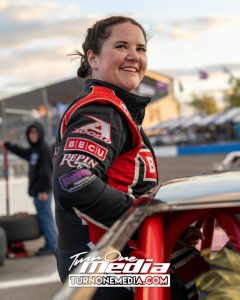
SCSC: What appealed to you about racing? Was it being down in that final lap and coming from behind and crossing the finish line first, or was it simply the thrill of going fast?
Deitz: I think it was just all of it: being there, having somebody to be able to watch and somebody who did well. Back in the day when I can remember at least going to the racetrack, they had A, B, C, D mains. There were so many cars in the Figure 8 class that you always wanted to see a wreck. You always wanted to see something happen. … But the thrill of going through the intersection, working with the rest of the competitors to try to get as close as possible to put a show on for the fans but not tear up our equipment each and every weekend. And the last few years, we started winning, and absolutely when that white flag comes out and you see you’re in first or second place with the opportunity for a win, it’s such a special feeling. And then being able to do it in the same place that my family races, it’s been incredible.
SCSC: When you first sat in the driver’s seat, do you recall what that feeling was having watched it but now it’s your first time doing it?
Deitz: I will never forget. I was terrified. I was terrified because I had never raced anything before. Usually when you grow up from a racing family, you start at a really young age. Well, I started later in life, and I had never raced anything before, really, go-karts. But I had never raced a car, and so just jumping in there, I would be sitting, waiting to come out of the pits, and my legs would be shaking just in anticipation and my nerves. And I didn’t want to let my family down. I didn’t want to wreck anybody else. I wanted to do well, and that still holds true today. But, I remember the first time going out, I was extremely nervous. I was worried about wrecking the car. My legs were shaking just sitting there before going out to take the green. And as soon as you do get out there and the green flag drops, it all just kind of goes away.
SCSC: When you’re training, does someone sit with you in the car, or is it all up to you? Is there a headset? How do you train to know, ‘Here’s the turn, and here’s the speed I need to make the turn’?
Deitz: It’s a lot of conversation. I don’t usually run a headset. You can run radios in certain races, and in our class you can. Not a lot of people do, except for the big races. But when I first started, I did not have radios, and so it was more they’d give me pointers, things to do, do the best that you can and try to be aggressive. The race would go, (and) I would just have to make the decisions on my own. And then you come back into the pits and recap with your crew and crew chief, and they give you feedback: ‘You did really good, but here’s where some of the challenges are.’ My mom actually has recorded almost every single race for me since I first started racing, and I will spend hours going back and watching the videos. I will actually sit there and point out, ‘That was a good move,’ or ‘You kind of messed up there. You need to do better next time.’ And so that’s kind of how that all worked. (The cars aren’t) double seaters, so you can’t have somebody in there with you. You just kind of learn it.
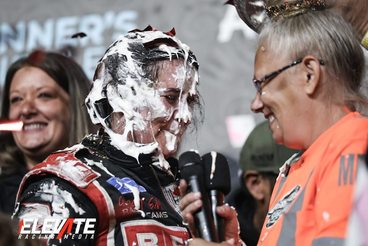
SCSC: What’s the average speed of the Figure 8 car?
Deitz: For our class, I would say it’s around 60 miles per hour. Going through the intersection could be a little bit less, could be a little bit more, just based on track conditions, car setup and things like that. But I would say about the same speed as being on Interstate 5.
SCSC: Do racers have a tough time driving on the road, like going to get groceries? It must be tedious to go that slow.
Deitz: When I was younger, I used to get in a lot of trouble with getting pulled over. I sped a lot, and I had a lot of tickets for speeding. And when I first started racing, I realized that I got to take all that out on the track. And so now for my day job, I work with car dealerships. I drive every single day from Bellingham to north Seattle. And for me, it’s not that bad. The one thing that I do have a really hard time with is roundabouts. I am very impatient in roundabouts because I race Figure 8. I’m used to taking a little bit of risk, and I get honked at a couple of times, but it’s all in good fun.
SCSC: You became Evergreen Speedway’s first female Figure 8 champion. You’ve recorded four, top-five finishes since 2021 and were runner-up in 2022. But to finally win it, what was that feeling when you crossed the finish line?
Deitz: It was absolutely incredible. I always joke that I’ve always been a bridesmaid and never a bride. I’ve finished second and third a few times but never got that No. 1 spot. And we set up and had a position last year where we could have won it. We came out of the gate pretty strong. We won the first two races and then had a total of five wins last year. But unfortunately, we also had a few DNFs that took us out of the running. So we did finish third last year, but this year we really focused on getting to finish every race and doing the best that we can. And when I found out that we won the championship and we just needed to finish that night, it was absolutely incredible. I started crying because it was such an emotional moment. We have worked so hard, my family and my crew and I and our sponsors to get there, and to be able to finally clench that title, it was so meaningful and an absolute experience.
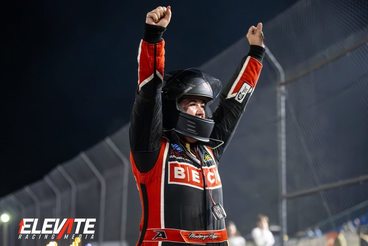
SCSC: How did you train this year? What changed, or did the training stay the same and sooner or later you’d get first?
Deitz: Training is definitely a part of it. A lot of it is based out of the preparation and what you do in the shop. This year, we made sure to go over everything with a fine-tooth comb before every race just to make sure that everything was ready to go: nut and bolt the car, double check everything to make sure that the suspension, the motor, make sure that we were not in a position where we would get another DNF. And huge shoutout to my team, my husband, my cousin Mikey who shows up and helps out, and my daughter who also races. It’s all in the preparation. It’s making sure that you take the time to check everything before every race, and that’s what’s really made a difference this year, as well as watching the tape and learning new moves or learning things (such as), ‘I didn’t do that very well that time. Maybe I need to try something new as far as passing people or getting stuck in traffic.’ … What has made a huge difference in my abilities is learning from other people as well as preparing and making sure that we’re ready to go on race day.
SCSC: In your post-race interview, you said “becoming the first female Figure 8 champions wasn’t just about crossing the finish line, but it was more about breaking barriers and paving the way for the continued growth in the competition.” If you asked someone to name a female NASCAR driver, people probably wouldn’t know of any, maybe only a few. Motor sports don’t have large numbers of female drivers. Why do you think that is?
Deitz: I don’t know why. It is difficult trying to be a female in a man’s world. When I first started, my grandpa sat me down and said, ‘You’re going to be racing, but here’s some things that you need to know. You’re going to have some challenges. There’s going to be people that might pick on you. There’s going to be people that think you can’t race because you are a girl, or you don’t have the ability.’
And I don’t know why more women don’t get into it. We’re extremely lucky here at Evergreen Speedway. We have a very large (number of) female competit(ors) within a lot of different classes. There’s myself, you have Haylie Wilkinson who runs in another class, … you have (Haley) Constance, Jessica Wilkinson. There’s so many other females that are running at Evergreen and even in our youth class. There’s more females in our youth class than there are males this year, which is pretty incredible. And so being able to watch the growth and see more people get involved and say, ‘OK. I can do this. Yeah, it’s hard, and I’m going to have to learn a lot. And it’s going to be different than (traditional) sports or something like that.’ But it’s so amazing to see that more people are getting into it. I think maybe people have the stigma, ‘Racing is a guy’s thing. Girls don’t do that.’ I think differently. Girls can do anything that a man can do and learn it. We might not pick it up right away, or we might need to learn the automotive side of stuff. But we have the same abilities just like everybody else, and that’s something that I’ve really tried to speak to the younger generation about. If you want to do it, you can do it.
In the youth class that I talked to, we had one of the girls who got into an accident earlier this year for her first race moving up to the youth class. And watching her grow from that and showing and telling her, ‘You have this. You can continue to grow and learn. This is just part of it. You’re going to hit something at some point, might as well get it out now.’ And it’s been absolutely incredible to watch Evergreen encourage young females and the women in every class that’s out there.
SCSC: What stereotypes have you heard within the racing community or things that have been directly told to you?
Deitz: I’ve had people make fun of me because I would come to the track with lipstick on or wear makeup. But that’s who I am as a person. I still enjoy racing, and I can do that with lipstick. That doesn’t make a difference of my skills or not. I’ve had people say that because I’m a female, I’m not as aggressive, and I’m not going to learn it. My grandpa always said, ‘You either have it, you don’t or you’re just never going to get it.’ And I think that for me, there’s been a lot of noise, and that’s what I call it. People can say what they want. I’m a female. I’m going to be me. I’m going to live my life, and I’m going to go out there and still do the best that I can every day. So, it doesn’t matter if I have lipstick or curls in my hair.
SCSC: Evergreen Speedway is the only NASCAR-sanctioned track in Washington state. How has it changed as you’ve raced on it? How has Monroe changed as a racing community over the years?
Deitz: The biggest thing is seeing the track specifically, seeing a lot more youth involvement and a lot more female involvement in all classes. The Youth Hornet class is such an incredible class that Evergreen Speedway came up with where there’s a WQMA Quarter Midget track across the street. … And Evergreen has really created an incredible program for kids and competitors to move up and start out from I think (ages) 12 to 16 or 12 to 15 in the youth class. And so that’s something that I have absolutely loved watching. … And watching these young kids jump into their first car at 12 years old, learn how to drive a stick the day before their first race, and now they’re out there running different classes, being competitive. My cousin was part of that youth class, and now he’s in an Outlaw, winning races and doing some incredible stuff.
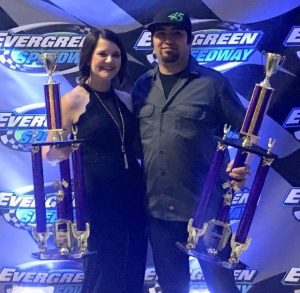
SCSC: Your husband is a part of your crew. Explain that relationship and camaraderie before and after the race and being around someone who’s won the championship a few times?
Deitz: My husband and I have a really good thing with the way that we work together. He does a lot of the work on the car, but I also jump in and kind of anticipate what he needs when we’re not preparing for the race, like when we’re not talking about what we’re trying to do for the race. But really it’s just teamwork. He makes recommendations. He tells me what opportunities I have or what I need to watch out for. And then after the race if we’ve done well, he’s one of the first people to come up and congratulate me. It’s such a special bond that we have because we understand each other. If he says something, I know exactly what he means. He takes the time to explain things to me so I understand when we’re talking about what the car is doing or what it feels like. If I’m telling him what I think we need to change and make the recommendations, he takes that in and listens to it. … There’s times where I’ve been like, ‘I want to try this change during a practice.’ And it was not the right direction, but he let me do it anyways. And what I gained from that is the knowledge and feeling of what a car will do when something gets changed. Let’s say it’s springs, the car handles differently, and so I was able to feel that, and now I can better relate to him.
SCSC: Where do you move up from this level of racing within Washington or the nation?
Deitz: The Super Stock Figure 8 class is an entrance into Figure 8, and so the step up from this would be the Outlaw Figure 8 class at Evergreen Speedway. And then the biggest, I would say, like the goal would be to someday end up racing in Indianapolis at the Speedrome. I call that race the Super Bowl of Figure 8 racing. It’s so incredible. There’s so many cars (and) such incredible talent over there.
SCSC: What’s your pre-race routine? Once you wake up, what are you having to eat? What are you doing mentally to prepare?
Deitz: I always have to have my coffee the beginning of the day. We get to the track early just to try and make sure we can get our spot and everything’s ready to go. I don’t usually eat the morning of race day, maybe a small pastry or something like that, but I don’t usually eat throughout the day just because my stomach still gets a little bit nervous throughout. But I do always make sure to have pickle juice, especially on hot days. The pickle juice definitely helps you stay hydrated because of the salt content (and) without having to drink a ton of water. And then my husband is Native, so we always sage the car before every race. I make him do that. It’s just a thing. It’s only weird if it doesn’t work. But we do sage my car and myself before every race, making sure we stay safe and in one piece and nothing bad happens.
SCSC: Anything else you want to add about racing at Evergreen Speedway and becoming the first female Figure 8 champion? You also said your daughter is racing.
Deitz: It’s finally hit me that that we’re the first female Figure 8 champion, and it’s been so special because the first year I raced, I sat down in my garage with my grandpa and I said, ‘I want to be the first female Figure 8 champion.’ And he was the inaugural winner of the Figure 8 Nationals at Evergreen Speedway. And we became the first female Figure 8 champion of the Nationals, (which was another first for us). … It’s been so surreal. It’s been incredible. There’s like nine of us among my family that race out there. … When I was out there watching my grandpa, you never would have imagined that 25, 30 years later that it would amount to this and create a legacy of his entire family, coming together and meeting on a track. It’s been pretty special, and I’m super proud of that.

